HUMAN SERVICES COMMITTEE - MAY 8, 2018
THOMAS C. BUCKEL, JR., CHAIRMAN
MEMBERS PRESENT: Dr. Chase, Mr. Rowley, 1Mr. Bush, 2Mr. Jordan
ALSO ATTENDING: See attached list
Chairman Buckel called the meeting to order at 10:07 a.m. A motion was made by Dr. Chase, seconded by Mr. Rowley, to waive the reading of the proceedings from the previous committee. MOTION CARRIED. A motion was made by Dr. Chase, seconded by Mr. Rowley, to approve the minutes from the previous committee. MOTION CARRIED.
1. Memorializing the Governor and the Legislature of the State of New York to Adopt the New York Health Act (Sponsored by Dr. Chase)
Chairman Buckel stated he agrees there is always a role for making a statement. However, if there is a way of coming up with a different or common solution that may fit the philosophical interest of all he would be interested in talking about that too. He then asked Dr. Chase to provide a brief overview of where things are and what she would like to accomplish with this.
Dr. Chase:
- Technically we are not the end-all-be-all to make this happen
1Mr. Bush arrived at the meeting.
2Mr. Jordan arrived at the meeting.
In answer to Chairman Buckel, Dr. Chase confirmed that the analysis on the financial impact to counties specifically related to Medicaid was previously handed out and has been passed by the assembly several years in a row. Chairman Buckel asked if the bill would, in fact, assume the complete obligation of Medicaid. Dr. Chase answered that the plan would be single-payer and technically pick up Medicare too. It would not allow for the continuation of private insurance; technically it would work like Canada’s does. The cost of private insurance has increased and estimates are that it will increase an additional 24% within the next 2-4 years. This is not doable for small business and is a huge amount of money for anyone with a large number of employees.
Chairman Buckel reiterated that he is not adverse, there is a role to play in making statements. Even if this goes down in defeat 12-5, the Democrats made a statement about something that is important. If there is a way, he is even more enthused about taking something this controversial and complex and fashioning a county answer to something which is sent to Albany to show that there may be bipartisan support for something that meets these goals. Mr. Rowley said he understands the point and agrees but he does not think the New York Healthcare Act is the answer. Dr. Chase has cited cost savings however, those cost savings are based on a model which is based on assumptions, and published analysis can be found both pro and con. Some of the assumptions used by Assemblyman Gottfried as saving are disputed, i.e. assumes 13% savings for administrative cost. The Urban Institute did an analysis of similar plans and said administrative costs are around 6%, another analysis of single-payer plans determined administrative costs are around 4.7%. The cost savings can absolutely be challenged but it is more fundamental than that, it is a difference in political philosophy. This is a massive takeover of the healthcare program in NYS. It includes absorbing Medicaid, Medicare, and the Affordable Care Act, all go away and come under a single plan controlled by NYS. There are a lot of pitfalls, we don’t know what the cost savings will be until it is implemented and can be measured. He cannot find a model where these assumptions are not challenged all over the map. There are other pitfalls in the analysis he is looking at relative to single-payer plans, which again boil down to a difference of philosophy. This is socialized medicine, a form of socialism, and he has not seen enough real-world experiences that show this model is effective, efficient and works well. When government gets involved with massive chunks of the economy his antenna goes up. This study also pointed out other drawbacks of this plan:
-
Would greatly expand a share of the state’s economy controlled by Albany, thereby multiplying opportunities for corruption; thinks Albany is a fairly corrupt town
-
Would establish a system of price controls with the Health department setting fees for every test, procedure, office visit and surgery performed within the state’s boards and would inevitably distort the balance of supply and demand; seems logical
-
Would centralize power over the healthcare system further empowering Albany’s shadow of government special interest and lobbyist
-
Would eliminate the disapproving interest of private health insurers who are the payer in the system with a financial interest to keep spending in check; certainly a debatable point
-
Would offer benefits that would be a magnet for residents of other states in need of costly care while imposing taxes that would put NY’s economy at a competitive disadvantage for job creation; NYS’s budget is $168 billion and services 20 million people, FL keeps attracting residents and businesses with a budget between $95-$96 billion while serving 21 million people
-
Taxes are too high in NYS and this plan does not help us a bit – not in favor of this plan
Dr. Chase asked who wrote the study. Mr. Rowley answered that this was just one study; Dr. Chase would say it was rightwing but he does not think the Urban Institute or Emory University are necessarily rightwing, nor some of the other sources. This is from the Empire Center and it is just one of the sources he looked at. Dr. Chase said that FL spends less, but the bottom line is that a number of people come from NY and are counted in FL’s numbers. When they need health care they come back to NY because FL puts people off, in their own socialized way, by denying them. This is also a big problem with private insurers. Like anything else, if you want to ensure coverage for everything it costs a fortune, then you have copays or must pay down before you can even take advantage of the insurance. The amount of money is astronomical for a middle-class family with more than one kid; some people have to spend $4,000 before being able to take advantage of anything on top of paying hundred per month into their healthcare. Even with the “Cadillac” getting mental health coverage is almost impossible. The best way to get mental health coverage is to be arrested, then you are sent into the system for help and most end up on Medicaid, which we are paying for. When they say 4% would be the administrative costs she question if they have any idea what insurance company administrators are making. One of her friends went from being a nurse at St. Joe’s to performing oversight for what is paid out for different claims and was paid $300,000 per year. That is wrong – paid $300,000 per year to tell people they don’t need a procedure. They are lying, 4% even 14%... Chairman Buckel interjected stating that the dialogue is terrific and very representative of the philosophical and economic debate we have on this issue. If we were to decide to grind through this, we could spend the next 10 years. Mr. Rowley agreed and Dr. Chase said that they have.
Chairman Buckel stated that we can put this to a vote, make our statement and move on. However he questioned if within the framework of one potential government-run health insurer or payer there is something collectively that we might be able to say to the state, i.e. don’t like this particular bill but if they did this with a, b, and c; gives them a chance to do something unique. If there is something worthy of talking about, and it’s not going to be a Ping-Pong match, let’s go forward. This issue predates us by 60 years and will go on for another 60 but if there is something viable that we might be able to collectively come up with, he would love to explore it. Mr. Rowley said, “I will be on the record that I agree with what she said in terms of healthcare costs being unaffordable and too expensive. Anything that would help in that regard I would certainly be willing to look at. But again, having a massive change to the extent that this plan would impose on New York State scares the bejesus out of me. It is one thing to provide affordable healthcare to people who truly need it, and I agree with that, but it is another thing to try to pay for it. If this is going to impinge upon the economy and drive businesses and residents away because we have to pay for it.” There is a balance there somewhere, don’t know what it is and don’t think this is it.
Chairman Buckle asked if the sponsor wanted to move this to a vote or had something to negotiate in terms of a bigger picture. Dr. Chase responded that she would have felt better if they had voted no. They didn’t have the guts to vote no in front of all those people, which annoyed her more than tabling it because the message was still heard that they are not on board for this. Mr. Rowley said that to have 20-25 people give testimony and not weigh their testimony, as a deliberative body, with some due diligence would be wrong as well. That is why it was tabled, we continue to discuss it and he continues to do further homework. By next session, everyone will be ready to vote regardless of the number of speakers on this subject. Chairman Buckel said, “For the record, the chair will acknowledge that even when I disagree with others I think they have guts and good faith. Peggy’s point is that it did not go for a vote and it should at some point.” Mr. Rowley stated he understands. Mr. Jordan stated he understands that also but there was not enough time to perform due diligence in terms of research at the time of the session. His past research was not favorable to single-payer systems but in fairness, he wanted to review this proposal. Tabling the proposal was the best thing to do in order to give him time to research the information provided and gather his own information. He understands Dr. Chase’s frustration but he is not one to just say “up or down”, without making an informed decision. In support of familiarizing himself with the NY Health Act, he started reading Professor Friedman’s 56-page report. Dr. Chase said that this is not a new concept, the legislature has been voting on this for years.
A motion was made by Dr. Chase, seconded by Chairman Buckel, to approve this item. Ayes: 2 (Chase, Buckel); Noes: 3 (Jordan, Bush, Rowley). MOTION DEFEATED.
Chairman Buckel said that the item can still go to the floor. Dr. Chase stated that this has been talked about for years and years and those opposed haven’t come forth with anything. Mr. Jordan responded that we are talking about the efficacy of assumptions that go into a lot of these projections. The Affordable Care Act is a perfect example before it was enacted it was going to lower insurance premiums and be a windfall for everybody, and the exact opposite has happened. Insurance rates and deductibles have gone through the roof, the projections made prior to enactment have been proven to be completely wrong. Chairman Buckel said that a vote has been taken. The data is not crystal clear on either side. Dr. Chase said that it is similar to opening a company - all sorts of projections can be made but you do not know until it is done. Mr. Jordan and Mr. Rowley agreed. Chairman Buckel reiterated that a vote has been taken.
2. Current Statistics, Issues for Policy Study and Action
Chairman Buckel:
-
Statistics put forward are not for action items, wanted to make them aware of Temporary and Disability Assistance Statistics published monthly, a tool to be aware of each month; total number of households and persons on SNAP benefits provides a snapshot of what is happening in the county, number of people on SNAP gives a reflection of need
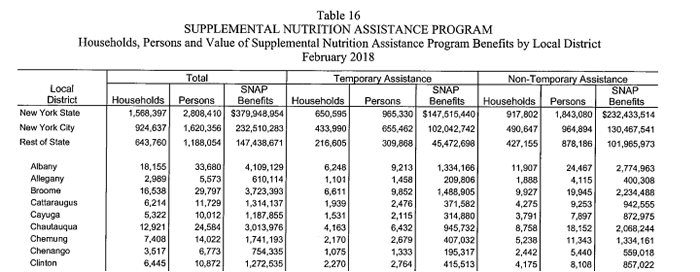
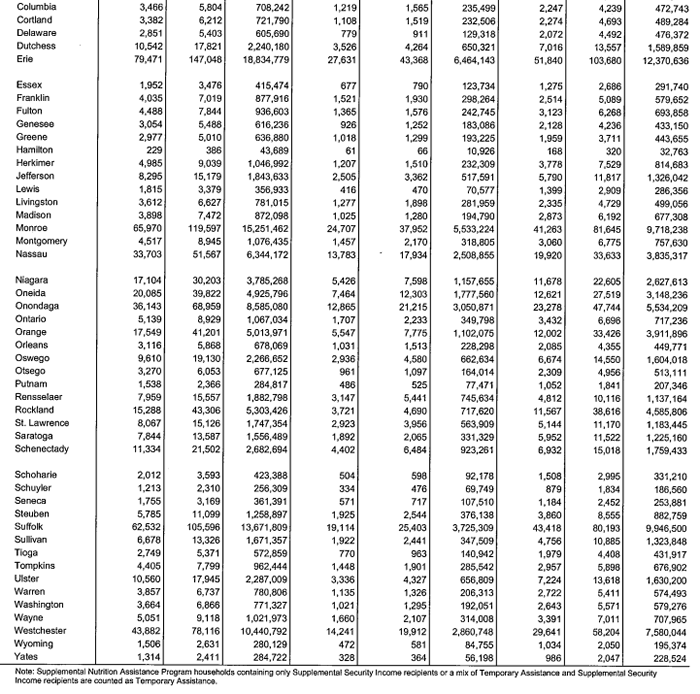
-
Apart from the philosophy of the programs and how to change them, this is a good starting point; Onondaga County has about 1 out of 6.5 people on SNAP; report not broke down by age or employment but an enormous number
-
Through our lifetimes Onondaga County has had a high poverty and even higher concentration of poverty, higher than the norm throughout the country and state, one could suggest that current policy doesn’t address this - hasn’t altered, want to use the committee process in our policy-making role to bridge philosophical differences and attack a real problem that harms individuals, families, and the overall financial well-being of the community, the amount of money, resources and programs, privately and publicly, that serve this population in need is huge
-
Want to begin to craft an agenda of items to look at, not adverse to the responsibility side of public policy any more than the underlying need of providing help; one current debate is whether work requirements and additional restrictions should be added to SNAP; given the long standing problems for this community he would love to see all issues on the table, would like to come up with 2 or 3 areas to look into; we can respond to what the executive and administration does or we can get proactive and wrestle with 2 or 3 big policy issues that we want to try to affect as a county
-
When discussed in general with the DSS office received pushback - much of what they do is governed by federal or state law, their hands are tied, having administered programs he found the greatest innovation, imagination and potential to do something is when you have those kinds of regulations, we can seek waivers of various programs if we come up with something creative to potentially change things
-
Has ideas but would rather defer to the committee to define areas to look at informationally, then more critically during the budget process, perhaps going into next year to begin the substance work of actually doing something
Mr. Rowley stated he did not disagree with the approach but as a legislator, and former CFO, he is trying to understand these programs and it is tough. He is still at a loss as to how they work and how we may be able to impact them from a policy perspective. The links given to review data and information provided was helpful but he would like to go one step further and be provided with links for sources that would describe the programs and how the policy at the state or federal level works. Chairman Buckel responded that he thinks this could be done and we could call on our administrators over the next couple of months. He thinks it would be useful and would consider also looking into assigned counsel; people misunderstand what the mandates and eligibilities are. He is looking to get a shared understanding of how things work, what we are supposed to do and then… Mr. Rowley stated other legislators might be more interested in his line of thinking, which is how our social service apparatus operates compared to other counties. His opinion is that we do pretty well, maybe that is a bad perception. Chairman Buckel said that he thought it was fair. His organization covered 13 counties that he interacted with daily. Some programs administrated some things better but in terms of the overall administration, and the effort to achieve efficacies, Onondaga County is as good as the central portion of Upstate counties; cannot speak to Erie, Albany or Monroe Counties. Mr. Rowley said that there was always discussion on caseworkers in the field, i.e. theory was that caseworkers for multiple programs and probation officers were tripping over each other; questions if there is a way to economize all those people in the field. Chairman Buckel stated or to make them more useful and targeted. Mr. Rowley agreed. Chairman Buckel said that those were some of the things that he has been thinking about over the years. In general, it may be counterintuitive to all but the benefits themselves typically should be much simpler to provide. Our time, effort and focus are better served on all those ancillary services, support networks, and pushing people out in a positive way. Mr. Rowley agreed.
Mr. Bush said that one of his main concerns will be delivery of services across the board as a county. Do we view ourselves as a county or little subdivisions were some get services and others don’t; our thought process has to use that as an underlying approach, which has typically not been done. Dr. Chase responded that it needs to be countywide but one needs to be aware that Skaneateles will not need as much SNAP as the City of Syracuse; it is not going to be even but needs to be fair. Just because they are spending more money in City doesn’t mean that people in Jordan needing help shouldn’t be paid attention to. Chairman Buckel said that the zip code data that is not protected. Those types of things are useful and also highlight public policy deficiencies. If we have a zip code where the majority of the county’s poor live public policy can begin to deal with that, that shouldn’t be the way a community is constructed. Mr. Bush said that a child living in a rural area needing mental health services deserves the same level of care. Dr. Chase said that they are not getting it in the city. Mr. Bush said that they should be. Dr. Chase said that none of them are getting it, which is a big issue. Mr. Bush said that this is an awareness that we need to look at. Chairman Buckel stated having spent almost 4 years in this field it is extraordinarily complex and you can see some fear from the DSS people saying the last thing they need is legislators medaling in the complexity. However, it is not beyond comprehension, the stuff that we can get a handle on really quick and the processes that are in play, and then as policymakers begin to look at something different. That is the beauty of county government, we have a clear problem, these programs are probably managed pretty well but the same results and consequences continue. The educational function is useful, he will call on the various agencies and departments to work with us; not going to turn them upside down, that fear can be put to rest. However, he would love to turn policy upside down and maybe do something innovative, lead the state in this and provide Jordan with services. Mr. Bush said that he wants services across the board. Dr. Chase and Chairman Buckel agreed. Mr. Bush said that when school districts in his area are not being served as well as some of the others in the county there is an issue that needs to be discussed. Chairman Buckel said that Jordan has a higher low-income population than other towns and is worthy of looking into. Mr. Bush reiterated that it is the concept that we are one county and we need to address this on that basis. Chairman Buckel agreed. Dr. Chase said that our interest in the school districts is to give certain districts support. She is on a committee that is looking at giving grants for various things that are important for the schools. The committee talked about ranking different kinds of organizations based on the kinds of things they provide to determine who they should support, and she was not on board with what they wanted as the majority wanted to do programs that would make kids work ready. She does not have a problem with that except for the fact that many of the programs they could fund contained mentoring, mental health support and things that make people ready to be work ready, not just finding them a job. We need to look at what we are spending our money on. We are spending money hoping that they get to the needing a job phase but are they emotionally, physically and educationally ready to be there. We cannot just give them a job, they need to be ready and a lot of it is from very early ages on up. Mr. Bush is correct, areas like his with poor populations need the same thing that the people in 13204 need.
A motion was made by Mr. Rowley, seconded by Dr. Chase, to adjourn. MOTION CARRIED.
The meeting adjourned at 10:46 a.m.
Respectfully submitted,

KATHERINE M. FRENCH, Deputy Clerk
Onondaga County Legislature
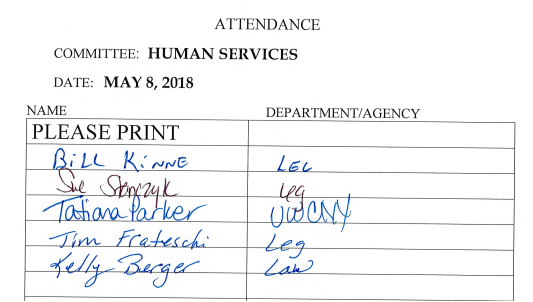
* * *
ENVIRONMENTAL PROTECTION COMMITTEE MINUTES - MAY 9, 2018
1MICHAEL E. PLOCHOCKI, CHAIRMAN
MEMBERS PRESENT: Mrs. Tassone, 2Dr. Chase, Mr. Burtis, Ms. Cody
ALSO ATTENDING: Chairman McMahon; see attached list
Vice Chair Cody called the meeting to order at 9:12 a.m. A motion was made by Dr. Chase, seconded by Mrs. Tassone, to waive the reading of the proceedings from the previous committee. MOTION CARRIED. A motion was made by Dr. Chase, seconded by Mr. Burtis, to approve the minutes from the previous committee. MOTION CARRIED.
1. WATER ENVIRONMENT PROTECTION: Tom Rhoads, P.E., Commissioner
a. Authorizing the Execution of Agreements with the City of Syracuse for Incorporation of Green Infrastructure within Specific Road Reconstruction Projects ($625,000)
1Chairman Plochocki arrived at the meeting.
Mr. Rhoads:
-
Have an agreement with the City for road reconstruction projects on 2 roads, green infrastructure on Berkeley Drive, Ostrom Place and South Geddes St., each in active combined sewershed areas
-
Discussed cost information last month, green infrastructure is far less costly than gray and combined road reconstruction projects with the City are the least expensive by far because the City is already doing the road work – WEP does the design, the City contractor creates the stormwater capture trenches underneath the road, and WEP reimburses the City for that work under the contract, excellent way to use one dig, smart design and construction philosophy
-
This work is already funded out of the combined sewershed funds, just asking to enter into IMA reimbursement agreement with the City of Syracuse; the City has already taken affirmative action to move this forward; not to exceed $625,000
Dr. Chase questioned where this was on Geddes. Mrs. Tassone responded that it was from Shonnard Street to Delaware Street.
In answer to Mrs. Tassone, Mr. Rhoads said that the money was coming from the Midland and Harbor Brook CSO ACJ budgets.
Chairman McMahon questioned if Berkeley was in the Midland CSO. Mr. Rhoads answered that Berkeley Drive is in Midland CSO 060/077 and goes up into the university area. Chairman McMahon said that this is a good project. Originally it came over with a companion piece about street sweeping. He then asked if he was correct to assume that we are now not doing any street sweeping. Mr. Rhoads responded that they have not been street sweeping yet, and he came prepared to speak on this matter if it came up. Chairman McMahon said that is a good idea.
-
Thanked the Chairman for the opportunity to help improve the understanding of what must be done for floatable control under the ACJ, have a responsibility to manage what the state calls floatable - any form of large detritus that comes out of the combined sewers
-
90% of the material that comes out the combined sewers is street litter
-
Annual report is on the website and contains all the work we do to remove the floatables (starting pg. 37)
http://savetherain.us/wp-content/uploads/2018/04/Appendix_A_2017CombinedSewerOverflows_AnnualReport.pdf
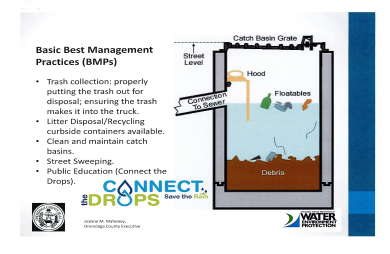
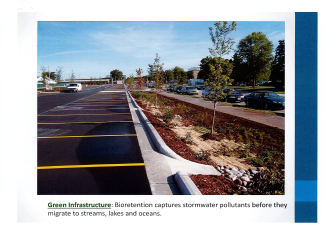 
- Most cost-effective way to capture litter is on the streets; we are doing this for ourselves not on behave of some other municipality
Chairman McMahon stated that others may have made that presumption but he certainly hasn’t. He agrees with what they are doing but questions where the IMA is. Mr. Rhoads responded, “We don’t need an IMA to work in the district.” Chairman McMahon said, “Sure you do, let me ask this question.” Mr. Rhoads interjected and said, “Let me answer your question - this is work that is required of the district so we are not being reimbursed by anyone and we have in our utility the right to do work in the streets, on the streets, in the streams. That is a right that we have as a sanitary district – we need no permissions from others.” Chairman McMahon questioned where the utility goes. Mr. Rhoads answered that the consolidated sanitary district lines are the utility.
Chairman McMahon asked when the street sweeping program would start in the Town of Geddes. Mr. Rhoads responded saying that when the Town of Geddes’s combined sewers overflow and it is a responsibility of our district. Chairman McMahon questioned if trash gets in the lake from the Town of Geddes. Mr. Rhoads answered that the responsibility of the sanitary district is the outfalls of the sanitary district – all the combined sewer overflow outfalls that are in our permits. The County has a permit with NYS and we are required to not have detritus come out of those permitted outfalls, those are only in the combined sewer areas. Chairman Plochocki stated Mr. Rhoads is saying that these outfalls are only in the City. Mr. Rhoads stated three-quarters of the combined sewer area is in the City and there is no other part of the combined sewer area that is in the sanitary district, it is only that portion of the City. There are MS4 outfalls in the storm sewer systems and maybe Mr. Glazier could describe this at another opportunity. As a district, we only have a legal responsibility and must file written reports on how we are managing the litter coming out of those outfalls. Chairman McMahon asked which streets would be swept. Mr. Rhoads responded that they will focus on “CSO orphan streets” – those that don’t actually have a relationship with one of the constructed facilities or sewersheds and don’t go to Midland, Clinton or Harbor Brook storage. All floatable control facilities have the ability to collect floatables at the end of the pipe but collecting floatables at street level is a more cost-effective approach. There are several CSO’s, generally in the southwest portion of town where floatables are not controlled by any of these improvement structures. Catch basin filters have been incorporated into all of our green infrastructures; filtered screens capture it there. Chairman McMahon asked to be provided with the list of orphan areas. Mr. Rhoads agreed to provide the list to all legislators. Chairman McMahon said legislators representing the City of Syracuse are often asked what their constituents get from the County and this is a service that the County is providing.
Chairman McMahon said that the last time this conversation came up there was an attorney present who basically said that they were working on the IMA for this same issue and questioned if that attorney decided… Mr. Rhoads interjected stating that they have reviewed the prehistoric records because the City of Syracuse gave many rights to the Syracuse Intercepting Sanitary Sewer Board. When we do catch basin cleaning we don’t ask for permission to do work that is a utility required work function. Chairman McMahon stated that he was not as concerned with getting permission from the City, he is more concerned with WEP getting permission from the legislature. This is where he thinks there is a question of… Mr. Rhoads interjected stating that he did not want to belittle what he thinks is a very important role and relationship, but the budget is prepared and floatable controls have been discussed as part of the operations budget and is a responsibility of the district. He would hesitate to suggest that it would be a good practice to have to ask for permission to do things that they are required to do. Chairman McMahon asked if he was correct in stating that we have been doing this street sweeping practice for decades. Mr. Rhoads responded that we have been doing the catch basin cleaning for over… Chairman McMahon interjected stating that over various decades we have been sweeping City streets. Mr. Rhoads responded that we bought the City a street sweeper. Chairman McMahon said that his point is that we have and at some point, a decision was made that this might be the most effective way to deliver our mandate but he thinks he is taking a reasonable position in that maybe that decision required the approval of the legislature. Mr. Rhoads said that in the Pirro era this County and sanitary district bought equipment and reimbursed the City for sweeping so there was an IMA. We are finding it more cost-effective and surgical to do it ourselves. Chairman McMahon stated that he wished the attorney was present who gave Mr. Rhoads that advice. Based on the advice they were given he is concerned about the form and substance of the resolution, and he does not see an attorney present. Mr. Rhoads stated that the only resolution for approval today is road recon. Mr. Fisher’s statement was inaudible. Chairman McMahon said that the legal counsel for the legislative chairman is the county law department and he does not think the law department can fire them from us.
Chairman Plochocki said that getting back to the green road reconstruction, to be clear street sweeping is a separate issue and we digressed to what was talked about last month. Chairman McMahon stated that street sweeping was part of the original resolution, which has been pulled and folks are not here to explain why. Chairman Plochocki thanked Chairman McMahon and said, “Yes that is correct. This was originally all together in one resolution” and asked that this is noted in the record. As for the portion, which is now the complete resolution before us today, last month we spoke of doing these sorts of projects with the City all the time. When the streets are open it makes sense for us to step in and do the things we have an interest in doing, particularly with regard to green infrastructure projects. This is a series of repairs and infrastructure changes that were going on with the City anyway. We are piggybacking off it and this aspect is nothing new.
A motion was made by Dr. Chase, seconded by Mr. Burtis, to approve this item. Passed unanimously; MOTION CARRIED.
Chairman Rhoads thanked the committee for their support.
2. OFFICE OF THE ENVIRONMENT: Travis Glazier, Director
a. Amending the 2018 County Budget to Provide for Use of Funds in Connection with the Onondaga Lake Waterfront Planning Project, and Authorizing the Execution of Agreements ($330,000)
Chairman Plochocki stated that last month he stated that this item would not be voted on and it would return this month. There was a good discussion but it is worthy of further discussion.
Mr. Glazier present the following:
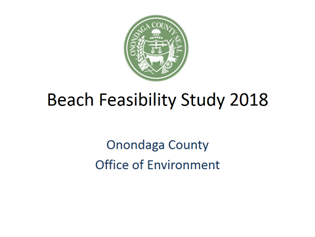 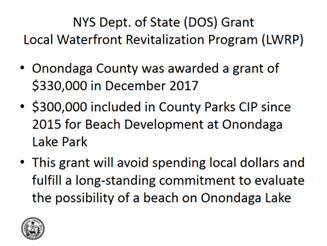
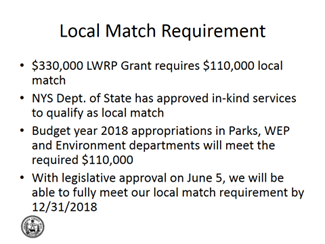 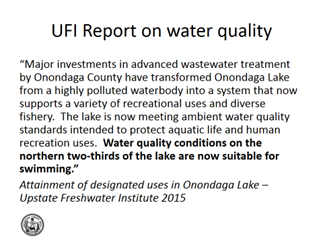
- The local match is $110,000
- Upstate Freshwater Institute (UFI) has a long history with Onondaga Lake and is an independent source
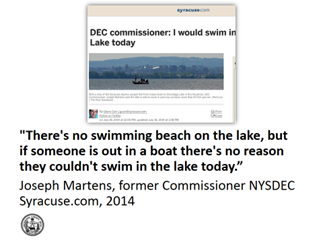 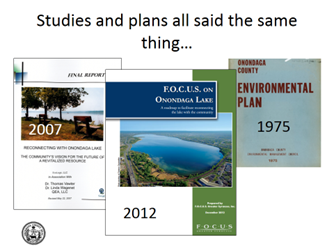
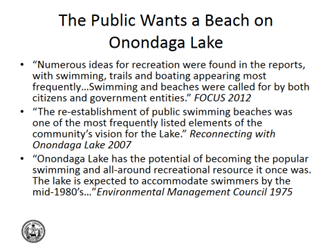 
-
There is a deep history of swimming in Onondaga Lake; various images of beaches were displayed showing the marina area, Danforth Saltwater Ponds that were located where the parkway is, Willow Bay, Long Branch, and the steps that are near the railroad bridge - the Parks department has uncovered a portion of them, there have been both public and private beaches with a variety of public bathing
- Showed video from the 2014 celebration of swimming in Onondaga Lake
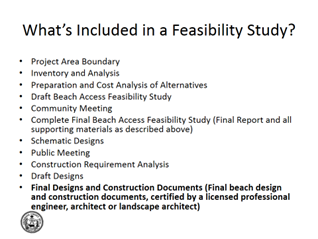 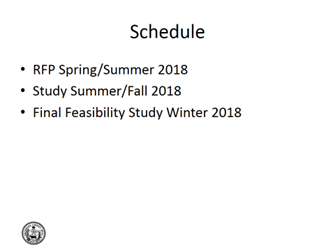
-
Final design and construction documents will be provided to consider the costs for beach construction on Onondaga Lake; schedule changed slightly from the last meeting, bumping back another month means really pushing to get the final study design by the end of 2018, important to move forward on accepting this grant
For the record Chairman Plochocki said, “I said something similar last month but if I could say it again – this really is, regardless of how this vote goes, regardless of the future with the beach, exactly how things play out, this is phenomenal, a phenomenal moment in history given that we’re even talking, seriously talking about doing a study with the intent of that study and all evidence indicating that the northern portion of the lake is ready for swimming.” This is not shocking news, as shown in the video people have been swimming in the lake and we have had good news for a few years, but we are officially talking about starting that first step towards a beach. Years ago he never thought we would be talking about this in his lifetime, it is a fantastic thing.
Mr. Burtis said that there is some bad information out there. This is a feasibility study, early planning for specifically Loop the Lake Trail, a beach, and to amend the budget to create a project account with our portion $110,000. He is in favor and believes that it is more than time to go forward. Chairman Plochocki said that Mr. Burtis hit some very important things. For the record Chairman Plochocki said, “One of them is again this study is not just about a beach. That is clearly the most significant portion of the study but a very important secondary and very significant portion of this study is about planning for the trajectory of the remaining portion of the Loop the Lake Trail. I don’t want to see that forgotten. Indeed as Tim was also saying, and Travis pointed out as well, there is an in-kind match in the amount of $110,000 but it is, I stress again the words, in-kind with this and the money can be currently found within the budget.”
Dr. Chase said that this is a good idea but seems like an awful lot of money for an evaluation. It is not as if there were never beaches there before; we are kind of redeveloping some area. Chairman Plochocki asked if Mr. Glazier had any comments. Mr. Glazier responded that final construction design documents are also included, which traditionally scopes out to be 8% of the overall project costs. Construction and design will be a large component, probably two-thirds of the costs. There are surveys and things such as that and the numbers add up pretty quick. Much of the history predates our current infrastructure so there is accounting for infrastructure that was not there; Willow Bay has not been a beach for probably 70 years. Dr. Chase said that there was not much there so making a beach should be pretty easy; it is not like taking out part of the parkway, it is still pretty open. Mr. Bush said that what will be received is listed on the slide (See pg. 5-5th slide) and to Mr. Glazier’s point, all these things are abnormally expensive. Mr. Glazier repeated that design and construction pieces are very costly but are needed for going to bid and for legislators to make a cost evaluation on the value. In answer to Mr. Burtis, Mr. Glazier confirmed that they would probably go out for an RFP the day after as the timeline is very tight.
Chairman Plochocki made a motion, seconded by Ms. Cody, for a brief recess.
Dr. Chase stated that she had to leave at 9:45 a.m. In answer to Chairman Plochocki, Dr. Chase confirmed that she would have to leave in 5 minutes but had no further questions. She stated that she wished it didn’t cost so much but, we can’t just dump sand, we have to do this right; she does not have a problem with this.
Passed unanimously; MOTION CARRIED.
2Dr. Chase left the meeting.
The meeting recessed at 9:42 a.m.
Chairman Plochocki reconvened the meeting at 9:46 a.m.
Chairman McMahon stated that the slide (See pg. 4-2nd slide) brought up something important for this committee to recognize. Although this has been in the capital plan the Legislature chose in 2017 not to take this up. Mr. Glazier should be congratulated for finding another funding stream. However, referencing the third slide (See pg. 4), Chairman McMahon said that he has concerns as he thought we were voting on a beach feasibility study where we are studying a beach and confirming data to go to the state health department for the appropriate permit or whatever is needed so that there is an opportunity for this community to once again have a beach on Onondaga Lake, if the policymakers so choose. But this is a little bit different and he does not believe that this slide is the same as what was presented at the previous meeting. His concern is that a vote on this item as presented is a vote for a beach, not to study the feasibility of a beach. Mr. Glazier responded that we still need funding to actually construct. Chairman McMahon stated that his concern is that the budget very rarely gets down to the actual dollars and cents. At no time has WEP talked about sweeping streets in there budget, yet they are saying they do not need permission from the legislature to sweep streets. This is a decision of large magnitude, to change our real estate and any dealings with real estate defiantly need legislative approval. We need to be talking about the study of the beach to tell the public that the feasibility of it is going to happen. This should not be approval of a beach or any sort of legislation that can be interpreted by the Executive as the ability for the executive branch to commission a beach project. He is curious about moving $110,000 into a project account and how that will work. Mr. Fisher stated he was speaking for the Executive office and until final design and construction documents are ready for bid you will not know the actual cost. This is the reason schematic designs often contain a contingency of 25% or more. Before the County Executive, as the chief budget officer puts forward a budget saying let’s spend money on a beach or the legislature considers a proposal to appropriate money for a beach we would like to narrow it down to a design that the public accepts. Getting the public aware and letting them tell us if this a good idea is key and having construction documents makes it possible to get a very tight estimate for the cost of the project, which we all want. We do not want uncertainty with environmental issues where the unknowns can be very expensive. The resolution speaks for itself. It does not say there is going to be a vote or a budget proposal coming from the executive office. It says there will be all these deliverables and at the end of that there will be a budgetary and political decision involving both branches of government. Chairman McMahon said, “I agree but the problem is by you putting that money in a project account that money essentially can be used for a project for a beach on Onondaga Lake so if what you are saying is true I am ok with that. But again the lawyers aren’t here. This time he would appreciate hearing from the executive’s lawyers, if they are not our lawyers, to say that the County Executive does not have the authority to start a beach with this vote. There would need to be an additional vote or additional appropriations in the budget.” To Mr. Fisher’s point, the public needs to be driving this demand and perhaps later in the process, the executive and legislative bodies may not agree on what the public is saying. As Chairman of the legislature he would love to have his colleagues have the final say because we are changing the real estate. Mr. Fisher stated that accepting the grant is what is in front of them. Chairman McMahon responded that a process has been put forth that is more than accepting a grant, it is putting funds into a project account and nothing here addresses his concern, which is that the legislature takes a vote before a beach is commissioned anywhere on Onondaga Lake. Mr. Fisher stated that principal legal construction is reading the words that are there and not those that aren’t. Those words are “In connection with the Onondaga Lake waterfront planning project.” Therefore a project is going to be established and the resolve is that “the County Executive is authorized to execute agreements necessary to implement the intent of this resolution.” The intent of the resolution is to establish a planning project and the materials that are part of the legislative record explaining the scope. Mr. Glazier has provided a detailed scope with 9 or 10 bullets. Mr. Fisher said, “You can’t go beyond that scope and remain within the intent so the language and you can have lawyers interpret it or you can use what we all learned in school, which is common sense. We read something and have common sense understanding of it.” Chairman McMahon said that he thinks he is a common sense guy but a lot of things these days don’t make common sense to him. This is a simple solution where he would love the executive lawyers who drafted this to explain it. Mr. Fisher stated that the County Attorney is the chief-sole legal advisor of all branches of government. Chairman McMahon asked where the County Attorney was. Mr. Fisher responded that the County Attorney and his staff are available to the Chairman. The County Attorney sent a letter to the Chairman explaining a concern. Chairman McMahon stated that Mr. Fisher was not included on the letter and asked how he knew. Mr. Fisher responded that the County Attorney provided him with a copy as it was a subject for discussion at their last meeting and he wanted to understand why there were no county attorney lawyers sitting at the bench. Chairman McMahon stated that he did not know. Mr. Fisher stated that the letter explained why that was. Chairman Plochocki stated that, while that issue is very important, he did not want to get too much into it just yet and asked if there were any further questions from other members.
Chairman Plochocki stated that he had a suggestion for going forward, on one hand, Chairman McMahon has some trepidation with this. Chairman McMahon said that he would like a little narrative on where the $110,000 is coming from in the existing budget - what departments and what was the original intent was for those funds. Mr. Glazier responded that it is personnel time for the ambient monitoring program - utilizing data that we are already collecting for the ACJ to establish water quality. It will be a historic look back but we can only count the data collected during that study period. Based on 2017 mathematics we determined that the personnel time dedicated from Parks and Office of Environment would amount to about $146,000. Mr. Fisher stated that there was a request from the Clerk of the Legislature and Chairman Plochocki to augment the original information sheet and an updated sheet was provided. If more information is needed we can put that in writing and make it part of the record, and the info sheet is the right place for that. When you start building up all this information in the resolution itself you get into more details than is necessary to move forward and makes it more difficult to implement the resolution.
Chairman McMahon said that he would hate to see this item face unwarranted opposition for a study. There needs to be clarification that this is not endorsing a final beach product without having amble input from the public and a second opportunity for the legislature. His concern is that some of his colleagues are taking the two as a whole. This is a great example of how this should work for any administration - when the legislature isn’t willing to spend money on a capital account the administrations finds another source. He would hate for this is to fail because of the language or concerns he has and the Law Department not being present to clarify it and he suggests amending the language. Mr. Glazier said, “The nature of the grant itself is for planning purposes, it is planning grant, not a construction grant.” Chairman McMahon said that he appreciates that but the use of a project account takes away… Mr. Glazier interjected, “We can’t add construction.” Chairman McMahon said that he did not understand the need for a project account for in-kind personnel time. Mr. Fisher responded, “Because the revenue side of this is a grant so when we pull in grants there is a grant agreement and in that grant agreement we’ve got in writing from the Department of State, we’re going to allow you to use these previously budgeted appropriations to qualify for the match part of it. We’re going to allow you to use our $330,000 for the stuff it says. Like we can’t spend $330,000 to build a beach because the grant doesn’t allow that. It is a planning grant like Travis said.”
Chairman Plochocki said that with Chairman McMahon’s clarifications he wants to make it clear that the chairman is not opposed but has expressed trepidation. Chairman McMahon said that he was actually in favor of the study but unless the County Attorney makes that same argument as Mr. Fisher he is not comfortable with this. Chairman Plochocki stated that the Chairman’s concerns may be shared by others and he has trepidation with the Chairman having concerns. At the same time, he feels Mr. Glazier has made a good case and he understands that there are reasons to keep this moving and not delay it further as they have already reflected on this for a month. In an ideal situation maybe this would be amended right now but that would require more wordsmithing. To balance the concerns and keep this moving he will support this and ask the other committee members to do the same. For the record, Chairman Plochocki said, “Our vote for this today, we are endorsing, in particular, moving this forward so that it can go to Ways and Means. At Ways and Means and/or at session and in the times between that we recognize there may be more wordsmithing done on this but rather than making those changes now we would vote this forward to keep this moving, which I feel is very important but at the same time there would be an understanding that members that are voting are not absolutely committing themselves to the language as it is.” This is a little unorthodox for obvious reasons but this is an unusual situation. He would rather not send this back to the drawing board for another month or more. He thinks they are close and worries that if they don’t vote for this it that it could stall things.
A motion was made by Chairman Plochocki, seconded by Mrs. Tassone, to approve this item as is “With the caveat for the record that all members voting for this recognize that there well might be wordsmithing still.” Passed unanimously; MOTION CARRIED.
The meeting adjourned at 10:03 a.m.
Respectfully submitted,

KATHERINE M. FRENCH, Deputy Clerk
Onondaga County Legislature
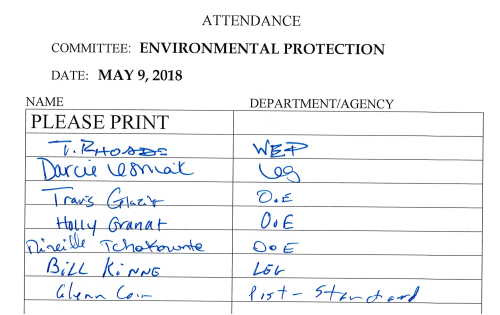
* * *
PUBLIC SAFETY COMMITTEE MINUTES – MAY 9, 2018
*CHRISTOPHER J. RYAN, CHAIRMAN
MEMBERS PRESENT: Mr. Rowley, Mr. McBride, Mr. Bush
MEMBERS ABSENT: Mr. Jordan
ALSO ATTENDING: See attached list
Vice Chair Rowley called the meeting to order at 12:05 p.m. A motion was made by Mr. Bush, seconded by Mr. McBride to waive the reading of the minutes of the previous committee meeting; MOTION CARRIED. A motion was made by Mr. McBride, seconded by Mr. Bush to approve the minutes of the previous committee meeting; MOTION CARRIED.
1. HUMAN RIGHTS COMMISSION:
a. Confirming Reappointments to the Onondaga County/Syracuse Commission on Human Rights (David Pasinski, Rosalie Young)
Vice Chair Rowley stated there is extensive backup, and they have been recommended by Chairman McMahon.
A motion was made by Mr. Bush, seconded by Mr. McBride, to approve this item. Passed unanimously; MOTION CARRIED.
Mr. Bush asked why the title of the commission includes Syracuse, and Mr. Paro answered it is a joint commission. Mrs. Berger agreed, and said it is the official title. Mr. Bush asked how it came about. Mrs. Berger explained originally in the 60’s it was a true joint commission, and in the 90’s it was reappropriated as a joint commission. Mrs. Berger believes there are appointments by the Mayor. Mr. Bush asked what the rational is for that, and Mrs. Berger responded it is a joint commission. Mr. Bush said the County Executive appoints residents inside and/or outside the City, and the Mayor appoints those in the City. It is not an adequate situation.
Vice Chair Rowley called for a recess at 12:08 p.m. The meeting reconvened at 12:12 p.m.
2. PULLED
3. EMERGENCY MANAGEMENT: Daniel Wears, Commissioner
a. Confirming Appointment and Reappointment to the Position of Deputy Coordinator and Authorizing Reimbursement for Expenses Incurred in the Performance of Duties (Gerald Payne, Christopher Evans)
-
Year ago hired all Deputy Coordinators; 2 are fulltime county employees who would like to continue in volunteer basis, because they cannot be in 2 titles at the same time
-
Represent department in field at meetings and other instances; compensated for mileage, but not paid; both on fire side
- These are not compensated; other Deputy Coordinators are paid hourly
A motion was made by Mr. Bush, seconded by Mr. McBride, to approve this item. Passed unanimously; MOTION CARRIED.
b. Amending the 2018 County Budget to Make Contingency Funds Available to Support Various Projects within Onondaga County, and Providing for Agreements as may be Necessary Related to Such Use ($20,000)
-
2 items in contingency: (1) Public Safety Critical Incident Management Class; taught at OCC twice; $10,000 total; class offered for free to first responders, and support organizations in private industry
-
Class goes over first 20-30 min of incident; how to better coordinate for more effective response
-
(2) $10,000 for Onondaga County Volunteer Firefighters Association; continuous through the years, except last year
-
Looking to buy a Public Safety Education Trailer for education and outreach (what money will be used for)
-
Do not think money is match; reimbursing expenses as part of operations; they’re saving money to buy trailer
- Typical attendance for classes – maxed at 30; 60 total between 2 classes
- Participants are primarily from Onondaga County; occasionally get 1 from neighboring County
A motion was made by Mr. McBride, seconded by Mr. Bush, to approve this item. Passed unanimously; MOTION CARRIED.
c. Amending the 2018 County Budget to Accept Funds in Connection with a Grant from New York State Homeland Security And Emergency Services, and Authorizing the Execution of Agreements ($210,000)
-
New federal grant program; state applied for on behave of number of upstate jurisdictions
-
Awarded $210,000 for planning, training and exercising
-
Under Complex Coordinated Terrorist Attack Grant Program – currently reviewing plans and hiring consultant; developing plans identified as a gap; participating in number of exercises
-
Part of grant application was doing a local exercise – table top exercise; will hire consultant to execute
-
Second phase next year is to send first responders to Oriskany training center; grant funding will back fund overtime for agencies, so they are able to send people to those exercises
-
Department is grant administrator; not only County employees go; could be (i.e.) Syracuse Fire; all first responders
- No local dollars
A motion was made by Mr. Bush, seconded by Mr. McBride, to approve this item. Passed unanimously; MOTION CARRIED.
d. Authorizing Execution of Agreements Regarding Use of an Oil Spill Response Trailer and Equipment Owned by the New York State Department of Environmental Conservation
-
NYS Dept. of Environmental Conservation (DEC) - provided County with Hazardous Material Response Trailer; oil spills are the focus; trailer equipped with resources to mitigate (i.e. absorbent pads)
-
No cost - given trailer; NYSDEC owns the trailer; County possesses trailer; department will do training and exercises for deployment if there is a large spill within the County
-
NYSDEC will own and maintain it; they will replenish supplies; they will do training
-
Emergency Management will help coordinate training for agencies; will deploy it to incident, and assist first responders in deploying the equipment
-
No maintenance; only thing department may do is inspect it annually
A motion was made by Mr. Bush, seconded by Mr. McBride, to approve this item. Passed unanimously; MOTION CARRIED.
e. Authorizing Execution of Agreements Regarding Mutual Aid Services Provided for Animals in Onondaga County by the Jamesville Fire Department
- Animal Response Team own 2 trailers of equipment; Jamesville Fire to deploy trailers to scene; will expedite time
*Chairman Ryan arrived at the meeting.
- Volunteers to respond to incident to participate and utilize equipment; equipment stored at Jamesville DOT
A motion was made by Mr. McBride, seconded by Mr. Bush, to approve this item. Passed unanimously; MOTION CARRIED.
The meeting was adjourned at 12:17 p.m.
Respectfully submitted,

JAMIE McNAMARA, Assistant Clerk
Onondaga County Legislature
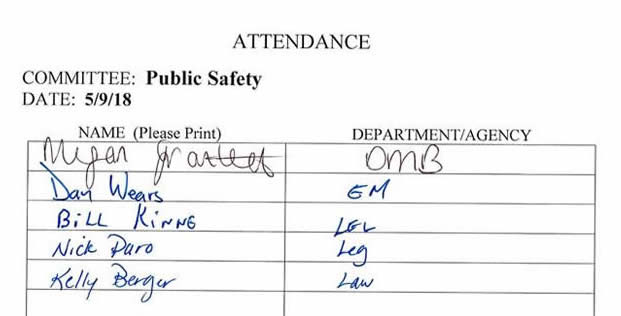
* * *
PLANNING & ECONOMIC DEVELOPMENT COMMITTEE MINUTES – MAY 10, 2018
JOHN D. McBRIDE, CHAIRMAN
MEMBERS PRESENT: Mr. Holmquist, Mr. Burtis, *Mr. Plochocki
MEMBERS ABSENT: Mr. Buckel
ALSO ATTENDING: Chairman McMahon; see attached list
Chairman McBride called the meeting to order at 10:32 a.m. A motion was made by Mr. Burtis, seconded by Mr. Holmquist to waive the reading and approve the minutes of the previous committee meeting; MOTION CARRIED.
1. SYRACUSE/ONONDAGA COUNTY PLANNING AGENCY: Don Jordan, Deputy Director
a. Renewing with Modification Agricultural District No. 1, in the Towns of Lafayette, Onondaga, Otisco, and Tully
A motion was made by Mr. Burtis, seconded by Mr. Holmquist, to approve this item. Passed unanimously; MOTION CARRIED.
b. Approving the Inclusion of Viable Agricultural Land Within Certified Agricultural Districts Pursuant to Section 303-B of the New York State Agriculture and Markets Law
Mr. Jordan clarified for Chairman McBride that last month they voted on the public hearing, and this month they are voting to approve the additions.
A motion was made by Mr. Burtis, seconded by Mr. Holmquist, to approve this item. Passed unanimously; MOTION CARRIED.
2. Route 81 Update
Mr. Lancette:
-
Member of Save 81 Coalition, which consists of citizens, elected officials, employers, union members and community groups throughout the area (not just City or County)
-
NYS Dept. of Transportation (DOT) completed draft environmental impact statement (DEIS) in Dec. 2016, when no longer considering tunnel options; circulated for select government agencies, but not public
-
Save81.org filed numerous FOIL requests for the DEIS over 6 months; obtained in June 2017
-
Jan. 2017, as response to public input and meetings, Gov. Cuomo asked NYS DOT to conduct tunnel feasibility study
-
When copy of DEIS obtained, asked John Shafer, PE, President of Spectra Engineering to review traffic analysis reported in study, and specifically to comment on community grid information
-
John Shafer has more than 40 years’ experience in field of transportation and infrastructure systems - 28 years at NYS DOT with 5 as Chief Engineer; 8 years as Executive Director of NYS Thruway Authority; currently President of Spectra
-
John (Shafer) will bring up very valid points and concerns that everyone in community should take note of
-
i.e. By 2020 more than 45% of southbound evening rush hour traffic under no-build condition would have origins north or south of central business district (i.e. hospital); for gridlock to be avoided, would need direct routing of city streets
Mr. Shafer:
-
Since last October, Spectra Engineering obtained by JMT
-
DEIS had 3 alternates released to public; 1 – No-build (required by federal law); 2 – Rebuild of viaduct 81 through City of Syracuse; 3 – Community grid
-
Specifically asked to look at community grid; does it serve the needs of the City of Syracuse, long distance travelers, economy, and traffic volume downtown; Concluded that it does not
-
80,000 cars/day on I81
*Mr. Plochocki arrived at the meeting.
- DEIS concluded 30,000 cars would stay on boulevard (heart of grid) up Almond St.; other 50,000 cars onto 481 to east
-
Difficult because many origins and destinations are within City of Syracuse; means 9 mile longer trip around 481 from south to downtown
-
Diversion of 50,000 cars/day to 481 would require lots of reconstruction including extra lanes, interchanges, etc.; an assumption of DEIS that leaves 30,000 cars/day on City streets
-
18 intersections at level service E or F (like grades at school; A is good; E and F are bad) – relates to congestion, traffic delays, queues that would back up at red phases
-
16 intersections with no traffic signals would need new traffic signals; 37 traffic signals would have to be redone with new arrows, etc.
-
By 2050 – 100 intersections within the City would operate at a level of service less than under the no-build
-
Major impacts on air quality; by 2050 - Carbon Monoxide and Volatile Organic Compounds (VOC) will be 2-3x higher with community grid versus the alternates
-
Maintenance costs higher with additional traffic signals; additional wear and tear on streets; significant burden on whoever owns the boulevard (parallel or on Almond Street)
-
Historically DOT takes over responsibility of freeway they built, and maintenance of streets below are municipality
-
Would guestimate if DOT takes viaduct down and creates grid, then maintenance of grid would be on the City
-
I81 highly responsible for economic development within City and outside City; changing this would have major impacts on suburban sprawl and how the region would continue to develop
-
Tunnel Feasibility Study finished at end of 2017; looked at 6 or 7 alternates including depressed highways
-
Basic conclusion – 4 tunnel alternates are feasible, meaning no ground water, no building foundations, nothing that would preclude it from engineering standpoint
-
Tunnels range in length from 1.2 – 2.6 miles; variation in length and costs; shortest $3 billion; longest $4.5 billion
-
Tunnel would end up with street on top; sort of hybrid; would not only replace through traffic and limited access highway (speed), but also result in major street improvements on top
-
Tunnel Feasibility Study did not look at access Syracuse tunnel, which is a little over a mile long; costs in $2 bil range
-
Value Engineering – technique where another set of eyes looks at design of project when 2/3 of the way along; looks at every aspect to reduce costs; not unusual to save 10%
-
Design build – municipality (state) puts out to single contract containing contractor and design engineering firm; many advantages like single point of responsibility, reduced time in evolution of project and reduced cost
-
i.e. Tappan Zee Bridge – estimated to cost $5 billion; put out to design build of contractors and engineering firms; bid cost was actually $4 billion; saved 20% of original estimated price
-
Public Private Partnership - number of large projects with private money involved; private companies have money to build project, then get reimbursed by (i.e.) tolls or municipality sells bonds paid back over time (manageable)
-
Schedule – redoing DEIS; Governor announced the revised DEIS would include tunnel; being put under contract by NYS DOT, and same consulting firm that did original DEIS; end result will be in 2019
-
Process – have to hold public participation and citizen participation meetings; then come out with record of decision
-
DEIS, community participation, public participation, final environmental impact statement and record of decision
-
Number of local governments and state elected officials have come out to support concept of I81
- Do not reduce capacity from 80,000 cars/day to 30,000 cars/day
- Do not expect 50,000 cars to go east
- Maintain limited access service throughout City of Syracuse - valuable in developing City and economy in region
-
NYS DOT looked at through traffic; only about 11% (counting south of 481 and north of 81) is through traffic; which means 81 currently serves 90% of traffic for local destinations
-
Do you want 50,000 cars/day finding their way through City’s street system, when now they get to their destinations quite easily on limited access highway?
Mr. Holmquist said it was a nice presentation, and continued:
-
Over past several years, there have been 11 public polls coming out 2-1 in favor of maintaining I81
-
State is looking for a consensus, and seems there has been consensus for some time; hardly anyone advocating for community grid; most are not taking into account all factors; dramatic impact to all suburbs
-
Community participation a major part; majority in favor of maintaining I81; improving it or hybrid option
-
Why talk about for years and years?
- Community grid advocates included in hybrid aspect; have piece of it, and still address the concerns with huge negative consequences
Mr. Shafer:
- Why has the community grid lasted in this process? Because citizen participation and public feedback quite vocal
- As an engineer, most telling is that 100 intersections denigrated significantly
- Do not believe those advocating for grid had access to this information, and what results would be; data from DEIS
Mr. McBride asked for an explanation of the E and F designations. Mr. Shafer answered:
Mr. Holmquist thinks that almost all the advocates for the community grid would not be advocates once it is built. Mr. Shafer believes most of the advocate’s motivation is aesthetics; like to see viaduct gone. They discuss community interaction, and there was a comment that taking out the viaduct would enhance community interaction.
Mr. Plochocki said it was an excellent presentation, and asked for an explanation of the CO emissions increasing with this plan. Mr. Shafer replied that stop and go traffic creates more emissions than free flow traffic. In 2050, there would be 2 - 3 times CO, VOC and particulate matter (three things typically measured in DEIS).
Mr. Plochocki said advocates claim to look at cherry picked cities (i.e. Milwaukee, WI) that got rid of their interstate, and have wonderful things happening. Mr. Plochocki asked for clarification that those cities have beltways that go all the way around the city. Mr. Shafer said generally yes. In this case, 81 goes from I40 in Tennessee to Canada. It is a major north/south corridor from a federal highway perspective. There is a process where I81 could be rerouted (which has to be applied for by NYS DOT), and it would have to be approved as part of the DEIS.
Mr. Plochocki said there are valid concerns from truck drivers that traffic patterns with a community grid would direct traffic coming from the south (i.e. Cortland) to the west (i.e. Geneva) to get off at the Homer exit or 481. Mr. Plochocki asked if things like this were looked at, or if it was concentrated on the City. Mr. Shafer responded:
- Focused more on center of City
-
At one time, DOT wanted to put trucks on 81; originated from south heading to Seneca Meadows; data looked at in that instance, and suggested it would not be easy to get trucks to use 81
-
Reasons - travel time during off peak; accidents on 81; have to go right through City of Syracuse to 690 or Thruway to get to Seneca Meadows; would truckers do that or stay on highways to west?
-
If building community grid, the issue would be worse; talking about trucks going another 9 miles out to the east; if they cannot expect truckers to use I81, then how would they be convinced to add 9 miles to their trip?
Mr. Plochocki said everything supports that. A DOT leader at a public forum claimed that there was a study done saying only 3% of truck traffic between Cortland and Geneva would go off the state system under a community grid situation. It was said that truckers would definitely stay on and go the extra 9 miles. Mr. Plochocki has spoken to many truckers, and they say that is not what they would do. Mr. Shafer would agree.
A motion was made by Mr. Burtis, seconded by Mr. Holmquist, to adjourn the meeting. Passed unanimously; MOTION CARRIED.
The meeting was adjourned at 11:04 a.m.
Respectfully submitted,

JAMIE McNAMARA, Assistant Clerk
Onondaga County Legislature
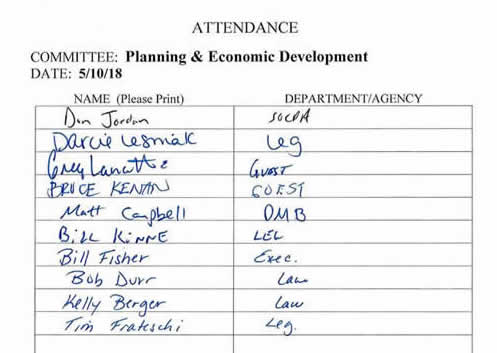
* * *
JOINT MEETING OF
WAYS & MEANS AND COUNTY FACILITIES COMMITTEES - MINUTES
May 14, 2018
BRIAN MAY, CHAIR JUDY TASSONE, CHAIR
WAYS & MEANS MEMBERS PRESENT: Chair May, Mr. Jordan, Mr. Knapp, Mr. Ryan, Mrs. Ervin, Mr. Plochocki
MEMBER ABSENT: Ms. Williams
COUNTY FACILITIES MEMBERS PRESENT: Mrs. Tassone, Ms. Cody, Mr. Knapp, Mrs. Ervin, Mr. Holmquist
ALSO PRESENT: Chairman McMahon, Mr. Buckel, Mr. Rowley, Mr. Bush, Mr. McBride, see also attached list
Chairman May called the meeting to order at 3:40 p.m.
1. ONONDAGA COMMUNITY COLLEGE:
a. Adoption Of Annual Budget for Onondaga Community College for the Fiscal Year September 1, 2018, to August 31, 2019, and Authorizing the County Executive to Enter Into Contracts with Other Governmental Units in which Appropriations and Revenues are Approved by the Adoption of the 2019 Budget
Dr. Crabill provided and reviewed the following PowerPoint presentation:

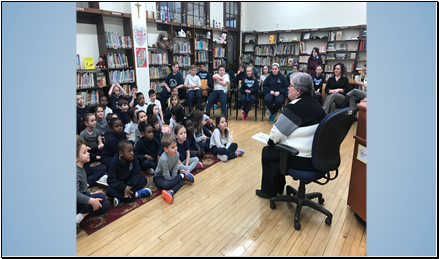
- Put focus on Community
- Worked closely with City School District – concern for regional employers that the students have more access to enhanced learning
- Worked with McKinley, Brighton, Roberts, Meachem – next year adding Delaware
- Enrichment to students typically in science, math, literacy – done by faculty/staff on a volunteer basis
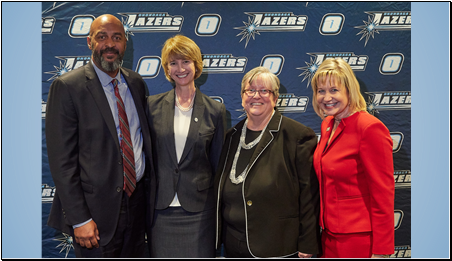
- New SUNY Chancellor, Dr. Kristina Johnson – will be a great asset to the system and OCC
- Very focused on workforce development
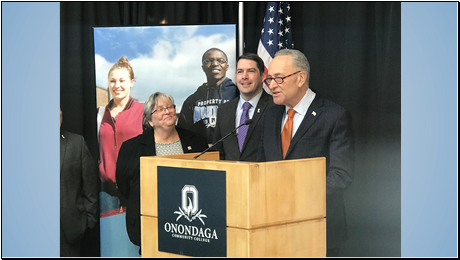
- Helped Senator Schumer with Say Yes issue – affected OCC greatly
- Had been a rule put in place that precluded sharing data with Say Yes so that student scholarships could move expeditiously
- Now able to share data; keeps students from falling behind or being unable to pay their bills

- Hosted Tesla – hopeful that the bill in Albany is successful allowing expansion of services center to Syr.
- Tesla has identified OCC as the training arm; have curriculum ready to go if able to
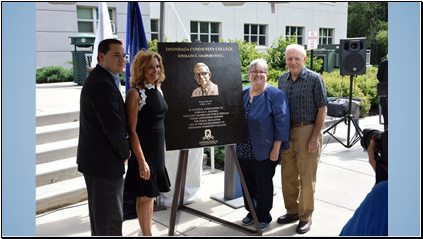
- Renamed H-3 Bldg, residence hall, to Ephraim Shapiro Hall
- Was the last of the founding legislators that hadn’t been named by a building
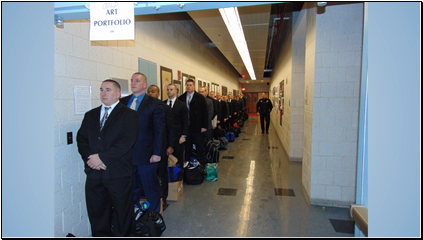
- Sheriff’s police academy in residence on campus
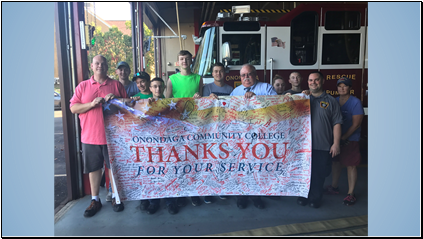
- 11 OCC students live in a fire house, Bunk-In
- They are on call, on staff while learning fire protection during the day
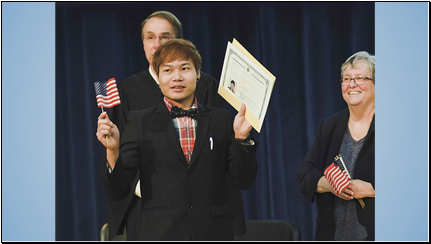
- Host naturalization ceremony in November
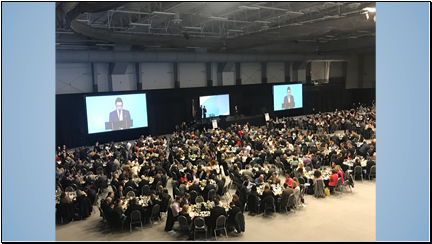
- CenterState CEO luncheon, 950 at SRC Arena
- Picked up a lot of events from Oncenter that was busy with bowling
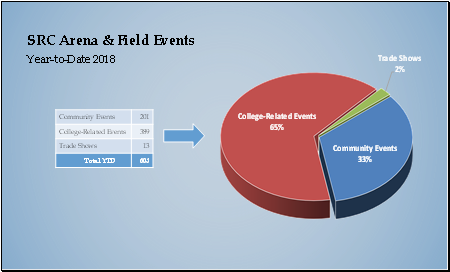
- When not busy, Police Academy uses arena for body drag training and running
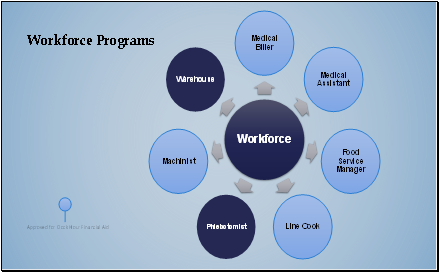
- Programs built with federal grant from 2 years ago
- Offered for adults, non-credit, available to people with or without a high school degree
- All locally routed – curriculums developed through a process of pulling in local employers – they task analyze things to be accomplished in their business
- Training is relative to the field in general and to the local employers
 
- Change entrepreneurs every 6 months, works with OCC with the Small Business Development Center and CenterState CEO to learn skills to run a business

- Train staff in the kitchen – staff comes from referrals i.e. Rescue Mission, Salvation Army, Catholic Charities
- Provides very basic kitchen skills certificate that will allow people to get the skills to get a paying job
- Has been a very successful, high visibility, workforce development program
 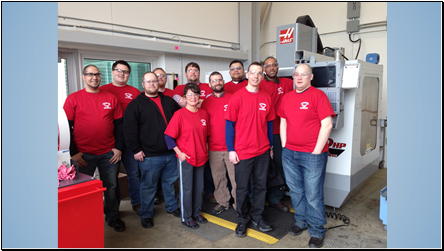
- New apprenticeship model – machine tool technology
- 3-month training program – companies hired the people before they even began the training
- Companies had input in who they wanted and what they wanted taught; training program to the employer specs; a 4 yr. apprentice model with the employer when finished

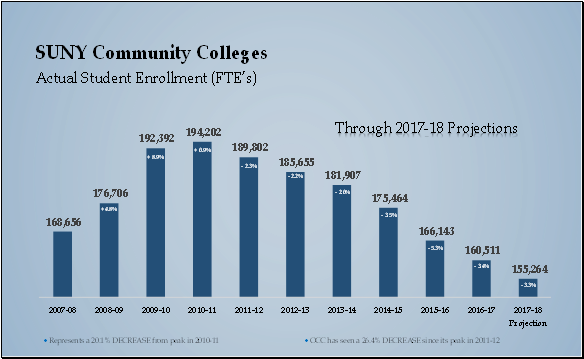
- Facing community colleges in NYS -- reflection of demographic trends in high schools
- In the enrollment decline, OCC has increased the percentage of graduating high school students that it is getting
- High school graduating classes shrinking dramatically
- Since 2011, enrollment is down just under 26.4%
- Reflected all across the state
-
Systemic challenge – Chancellor is working on it in a couple of ways
-
Funding from state derived by FTE – FTE is 30 credits
-
FTE could be as many as 10 people taking one course or it could be one student taking 15 credits/semester – a very old fashioned way of measuring enrollment back when most went full time
-
Talking with state about how they measure in terms of enrollment to make sure they are holding up their end of the economic support
Mr. Plochocki asked why this is a statewide trend. Dr. Crabill said that the only place in New York State that is growing is New York City. SUNY doesn’t serve New York City. She said if you look at the graduating classes in Onondaga County high schools and look at the enrollments, you would have to go back to the current 5th grade to find a class that is bigger than the one before. They are bigger by approximately 40 students countywide. It is a demographic wave hitting all of upstate. If the CUNY projection with NYC was included, it would go completely the other direction because they are gaining population.
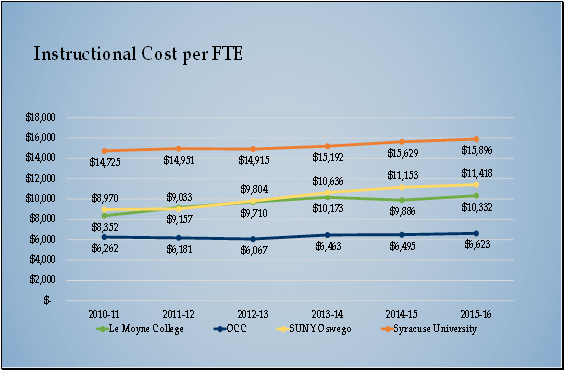
- Maintained expenditures per FTE
- Comparison of 4 yr. schools and OCC, public and privates
- OCC has been pretty consistent since 2010 in per FTE expenditure
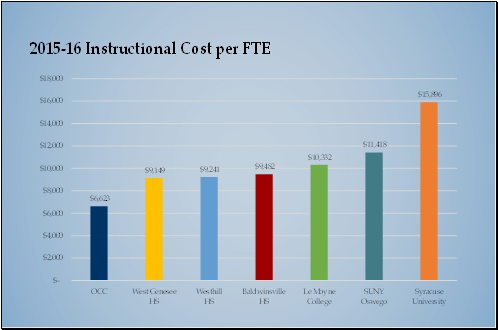
Chairman May asked if it is an all in cost. Dr. Crabill said that it is all in from an operating budget, not capital.
Mr. Bush asked where the City School rank. Dr. Crabill said that they will get the information and report back.
Mr. Buckel asked about the comparisons to community college peers in upstate New York. Mr. Manning, CFO, said that he will put it together based on their annual reports.
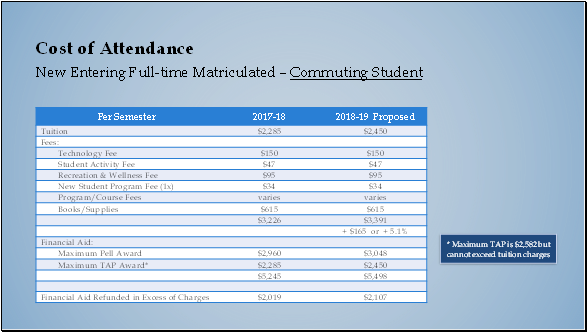
Dr. Crabill said that when they put the budget together for next year, they took the declining enrollment into account and looked at what might be possible. Last year, there was not an increase in tuition; this year the budget proposes an increase to students of $165/semester, which is $14/credit. They don’t want the tuition increase to impact the students who are the neediest. They look at the aid available to students, and even with the increased tuition, OCC is still significantly below the maximum TAP award. The neediest students would have their tuition paid through the TAP program, as they do now. The very neediest students typically also receive federal grants, which are refundable to the students for costs over and above. They are able to use that for books or transportation to school. Students who have the maximum financial aid will end up with almost $100 more refunded to them next year, even at the higher tuition rate. Students on the Excelsior Scholarship program will not be impacted. When the Excelsior Program passed last year, it set the tuition for those students for a four year period. A small group of students that would pay the increase tuition are: part time, below nine credits and are therefore receiving no financial aid, or students whose family adjusted gross income exceeds $110,000.
Mr. Knapp said that many fees are not reimbursed. Dr. Crabill agreed, noting that they have not increased their fees in the time she has been there and she thinks for two years before that. Fees are not covered by TAP, and for students who go part time and are reimbursed by their employers, the employers don’t reimburse fees either. Fees are always money right out of a student’s pocket and there is no access to aid to help them with that.
Dr. Crabill said that if they go ahead with the budget, which the board has endorsed with the increased tuition, and the impact of declining state aid reflecting enrollment, they are able to do so without additional operating funds from the county. It will be the same level of support that the county provided last year.
Mr. Knapp asked about capital. Dr. Crabill said that from a capital standpoint, they are still working on the facilities master plan and completing the last project that the county funded. There is no capital request this year. Going forward there are two areas where she thinks there will be capital requests in a year or so: 1. replacing of mechanical systems, which they had studied; 2. classroom renovation and refurbishment. In answer to Mr. Knapp, Dr. Crabill said that the library is finished. There is a small piece in Ferrante Hall that is still being completed – anticipated completion is early fall.
Chairman May said that there are a couple things that are noteworthy. The head count going down. There are great answers on the forecast and accounting for all of this now and going forward. It is 7 – 8 years before they will see a field of possible candidates come to OCC. He noted that he has only gotten through about half of the budget, but head count is down about 16% and expenses and revenue are down as well. Some of it it fixed costs.
Dr. Crabill said that one of the things they are doing to address the enrollment challenge, aside from trying to grow the young population, is the Weekend College, which is aimed at working adults. In looking at Dept. of Labor data, it says that 43% of the jobs in Onondaga County will require something after high school. Only 23% of adults age 24 and over in Onondaga County will have some after high school education. There is a miss match. Most adults can’t take 2 years off to go back to school. The weekend model is where the program will run year round, and they will finish 64 credits in that year. The starting curriculum is business administration. SUNY Oswego, at the downtown center, has agreed to develop a weekend version of the junior and senior year. It allows people some hope and ability to plan. The advertising was released today; a few news bits were done last week, and already 78 people have inquired and 23 have completed full applications. Once approval is received from SUNY, the plan is to add early childhood education, criminal justice – which has a 4 yr. follow on at SUNY Oswego, and alcohol and substance abuse counseling.
Chairman May referred to changes made with staffing. Dr. Crabill said that they have affiliate organization – decision made early on to get the housing developed and get the arena developed. She has made some changes. The way housing was set up previously, was that the Housing Corp., which owns the debt on the residence halls, also employed the staff for the residence halls. Dr. Crabill said that she was uncomfortable with the distance between college and Housing Corp. A charge back situation was set up from the Housing Corporation. They still hold the debt on the property, but contract with the college and pay the college to support the staff. It is college staff and she can have her hand on them. The reserve funds that they established for the purpose of refurbishing furniture, roofs, boilers, etc., were kept, because those costs should never come back on the college. Onondaga Enterprises was the group that ran the arena, and it seemed like an unnecessary distinction. The college has now assumed that work, and that corporation has been dissolved. The reserve fund which was established for the purpose replacing athletic fields, turf, arena floor, equipment, has gone to the Foundation in a dedicated reserve. The funds will be available when those costs arise, so that they don’t come back on the college. The college is doing the work of the events, and the revenue from the events are coming to support the college.
In answer to Mr. Knapp, Dr. Crabill said that the Housing Corporation has to stay because they manage the debt. Other than that there is the Foundation, which raises scholarship money and gives it out to the students. The Faculty/Student Association, OCCA, collects the student activity fee and runs the intermurals, clubs and organizations, and student government.
Ms. Cody asked how many students the Excelsior Scholarship brought in. Dr. Crabill said that it was announced in late April, they received the regulations on May 27th, and the applications were released June 7th. This year they took in 500 applications, each one had to be reviewed. All of the other financial aid had to be awarded first, and then if there were any dollars existing on tuition, Excelsior could fill that in. From the 500 applications, 269 students had some tuition needs. The smallest need was $3 – all the way up to full tuition. She feels that that this year they are likely to see more students because it’s been out there a year, and the rush was very confusing to people. Excelsior requires that a student must earn 30 credits in a year. The Foundation has been reaching out to students who hadn’t quite hit the 30 yet, and encouraging them with scholarships for summer school so that they stay eligible. Once you lose eligibility, you lose it for life. Even if they don’t have tuition needs here, they can take that scholarship with them and transfer where their need may increase. Ms. Cody asked if the Weekend College students can apply for it. Dr. Crabill said that she believes so; they do qualify for PELL and TAP, because they are full time students. They don’t see why they wouldn’t qualify for Excelsior unless they already had used financial aid or gone to college in the past. Excelsior is only for new students.
Mr. Knapp asked Dr. Crabill about the Oswego effect with the Excelsior Program. Dr. Crabill said that with the Excelsior opportunity, Oswego had over 14,000 applications for less than 3,000 slots. It was the most applications they had ever had in the history of the college. There were a lot of people they would be turning down. An arrangement was made with Oswego, that when they turn down a student, they refer them to OCC – even out-of-town students, because there is housing. SUNY has helped pay for a position that will be on OCC’s campus but will be knowledgeable about Oswego, and will work with those students for the two years they are at OCC to make sure they get on the path they wanted in the first place. So far there are 35 students that have taken them up on it.
In answer to Mr. Plochocki, Dr. Crabill said that the 4 year schools in the SUNY system are not experiencing the enrollment trend yet. The private schools are – they are struggling financially and with enrollment. Most of the regional privates did not make enrollment targets this year.

Mrs. Ervin noted that OCC just graduated the largest class it ever had. Dr. Crabill agreed – 620 participated, but over 1,100 received degrees. She noted that this year there were parents that brought their kids across the stage. OCC is creating situations where the first person in the family has made that step and gotten that college degree, and families don’t go backwards.
Chairman May noted that the public hearing will be held on Monday, May 21st at 9:00 a.m.
The meeting was adjourned at 4:20 p.m.
Respectfully submitted,

DEBORAH L. MATURO, Clerk
Onondaga County Legislature
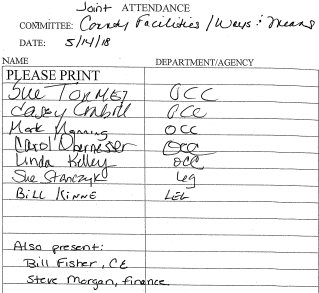
* * *
WAYS AND MEANS COMMITTEE MINUTES
May 21, 2018
Brian May, Chairman
MEMBERS PRESENT: Mr. Knapp, Mrs. Ervin, Mr. Plochocki, *Ms. Williams
MEMBERS ABSENT: Mr. Ryan, Mr. Jordan
ALSO PRESENT: Chairman McMahon, Mr. Bush, see also attached list
Chairman May called the meeting to order at 9:20 a.m.
A motion was made by Mr. Knapp, seconded by Mrs. Ervin, to waive the reading of the minutes of the proceedings of the previous committee. MOTION CARRIED. A motion was made by Mr. Knapp, seconded by Mrs. Ervin, to approve the minutes of the proceedings of the previous committee. MOTION CARRIED.
Chairman May took the agenda out of order:
4. ONONDAGA COMMUNITY COLLEGE:
a. Adoption of Annual Budget for Onondaga Community College for the Fiscal Year September 1, 2018, to August 31, 2019, and Authorizing the County Executive to Enter into Contracts with other Governmental Units in which Appropriations and Revenues are Approved by the Adoption of the 2019 Budget
Chairman May noted that the public hearing was held, this was discussed a few times. There was a joint meeting with County Facilities Committee; members have had the budgets and there has been plenty of time to look at them.
Mr. Knapp made a motion to approve this item.
Mr. Knapp stated that Dr. Crabill and her team continue to do a great job for the taxpayers and stretch a dollar as far as it can be.
Chairman May said that what is commendable about this budget is the fact that there is nothing OCC can do about it, but the population of students for the next several years is on the decline and the college is doing its part to make dollars work – make less dollars work. That is good for county taxpayers, the state, and the students who have to pay the bill. Chairman May commended Dr. Crabill and her team for doing so, for planning for the future along those lines, as it will be a few years before the student population will go up. Additionally, the program development happening at the college continues to improve. He noted that the Weekend College is a great idea and it is great that it is being implemented – it makes the school more applicable to the needs of this community, and more people will benefit.
Mrs. Ervin seconded the motion to approve this item. Passed unanimously; MOTION CARRIED.
1. WATER ENVIRONMENT PROTECTION: Tom Rhoads, Commissioner
a. Authorizing the Execution of Agreements with the City of Syracuse for Incorporation of Green Infrastructure within Specific Road Reconstruction Projects ($625,000)
- Road reconstruction project with the City of Syracuse
- Save the Rain projects – capture storm water within the combined sewer system
- No additional funding - projects funded out of ACJ capital plan budgets
- Asking for ability to enter into an IMA with the City of Syracuse
- City is doing complete reconstruction of the roads – County gets in and does design to put up underground storage underneath roadways – significantly reducing the cost of infrastructure
Mr. Roads distributed the following:
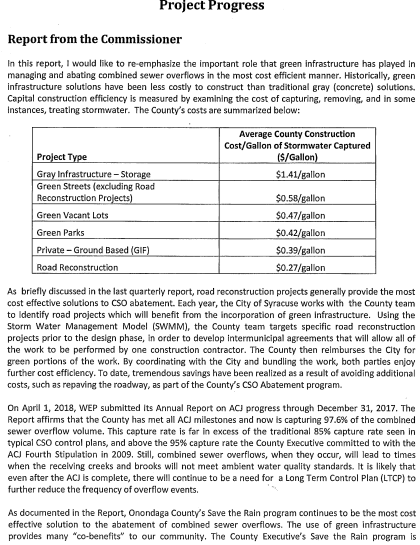
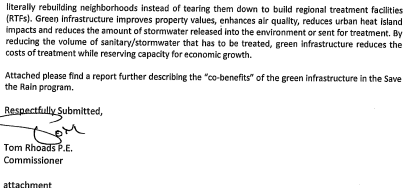
Mr. Plochocki said that he supports this item. The road reconstruction is a project that the City is doing anyway - and the County tries to piggyback with the City for everyone’s benefit. Periodically when they do road reconstruction projects, because the road is ripped up, it is an ideal time and part of the reason the cost is so low per gallon. He said that WEP has done a great job of spending the funds, that the legislature already allocated for the ACJ, very wisely. Chairman May agreed and stated that 50% cost savings is a big deal.
A motion was made by Mr. Plochocki, seconded by Mr. Knapp, to approve this item. Passed unanimously; MOTION CARRIED.
* Ms. Williams arrived at the meeting.
2. OFFICE OF THE ENVIRONMENT: Travis Glazier, Director
a. Amending the 2018 County Budget to Provide for Use of Funds in Connection with the Onondaga Lake Waterfront Planning Project, and Authorizing the Execution of Agreements ($330,000)
Mr. Glazier presented the following:
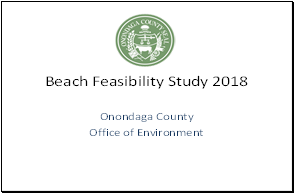  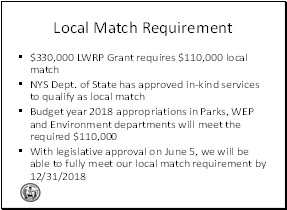
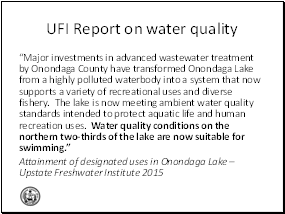 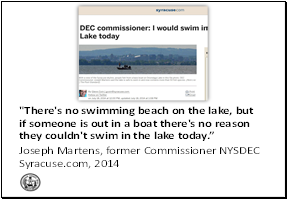 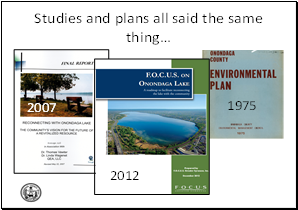
 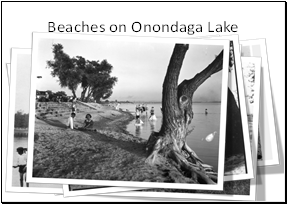 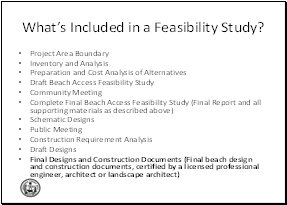
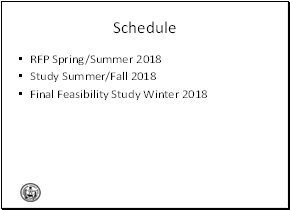
Mr. Knapp said that there are some funds included in this for the final portion of Loop the Lake Trail. Mr. Glazier agreed noting that because there is an LWRP, they utilized the entire eastern shoreline of Onondaga Lake. Included was some visioning pieces – a possible market analysis that can be utilized for Loop the Lake, $30,000. When DOT makes some decisions about Rt. 370, and as we get into construction at Murphy’s Island trail extensions, we can start to have some public conversations about how to continue to loop the lake – just to begin the process.
Mr. Plochocki said that he supports the study and appreciates the executive branch getting a grant to cover this and for the match being done with in-kind services. He said for the record, “based on discussions with other legislators, I have decided that I am going to be putting forward a companion resolution to this. A brief one, a memorializing resolution, which just states explicitly that in approving this study, the legislature is not approving building a beach at this time.” Mr. Plochocki said that some might say that that is obvious or not necessary, but many legislators want the resolution and want to be explicitly clear. Mr. Plochocki said that the idea of doing this study, paid for by the state, that can bring us to a point that should a future legislature decide it wants a beach, is very good. In answer from Chairman May, Mr. Plochocki stated that he would bring the resolution to the June session and ask for waiver.
Chairman McMahon said that this was an item that was in the capital improvement plan a couple of years ago. The legislature didn’t move forward with it because we didn’t want to spend local dollars on it. Mr. Glazier and his team found a state grant, which should be done in situations like this. He agrees with the fact that we have had beaches and the water is much cleaner. One of the things that concern him, and why it is important that Mr. Plochocki bring a resolution forward, -- not a memorializing resolution – is saying that what is being advanced here today is the ability to get through the bureaucratic red tape and have a policy decision of the legislature later on as to whether or not we want a beach.
Chairman McMahon noted that the FOCUS survey was actually on the first agenda when he became chair – it was not a scientific poll – it’s an engagement and good to have. He put out a survey last week, which was not a scientific poll. This will allow us to get the Health Department to say that the water is clean enough, so that you can have a beach if you want, and how much a beach could cost. Because there is final design, the resolution by Mr. Plochocki is important because it could be implied by an administration that they don’t need legislative consent if there are specific dollar amounts going forward. This a great story, a great comeback story with the lake, an emotional story for the community, but we haven’t talked about the business case – do we really need a beach. Regarding the beaches we have now – do we have capacity; is there a reason why we should have a beach here. Legislator Plochocki’s resolution is really important to clarify that we want to have this as an option to act on, but this isn’t the actual commissioning of a beach because there hasn’t been a business case made for why we should have one there.
Mr. Glazier agreed noting that the water quality for this is not up for question. There is long-term information, which makes it clear that had there been a beach on Onondaga Lake, it would have been continually open for the last eight years. Where there are closures like on Oneida Lake, Cazenovia Lake, etc., because of water qualities, Onondaga Lake with a beach on the northern two-thirds where you can have a public bathing area, would have been continually open throughout that entire time period. He agreed with Chairman McMahon that the things to look at are: what’s the need, what’s the access to people. He said “we know that the water quality in Onondaga Lake is such that it can support this activity with great confidence.”
Mr. Knapp asked if the EPA gets involved in the water quality or just the DEC. Mr. Glazier said that for having a public bathing area, EPA has guidelines. DEC and NYS Department of Health do the final sign off – we would apply to our County Department of Health. DEC and NYS Department of Health set the standards – they are completely in sync. He noted that applying to have a beach does not mean we are ready for construction. Technically the DOH and testing ambient monitoring, the data we have which brought us to this point, are two different types of tests – its semantics and science. There is no real fundamental difference. He said “we know that this process will go through; the Department of Health will approve it – the water quality is such, but that process won’t actually happen – not at a point to construct a beach.” He said that is what they will go through in this study – to really clarify that better.
Mrs. Ervin said that she support the study, but is glad for Mr. Plochocki’s resolution. We are not ready to say that we want a beach. It is a nice thing to have, but that has to come after all of this happens. The decision to build a beach is much further down the line.
Chairman May said that he is excited about these developments and is proud to have a tiny roll in being involved in these decisions. He has logged a lot of miles on the trails around the lake and enjoyed it very much and will continue to. The redevelopment of the western shore, Solvay/Geddes area, is exciting, reformative, and fantastic. As an outdoors person, he said he is most excited about the water quality improvements – the ultimate sign of all of the momentum taking place. He said he is a linear thinker, and wants the business case first. There is a way to go for community buy in; we have an advantage – have the data and information, but the community needs to learn and do more. He commended Mr. Plochocki for driving forward the condition that we are not building anything, just studying. He said that even though the match is in-kind--in some respects it is work that we are already doing--if he votes for it, it is saying that he wants this to be a priority. Chairman May said that personally he has other priorities for county government right now. He will vote against it today; is excited it is being talked about, but has other things that he’d rather be working on at the moment.
Mr. Knapp said that study wise, some of it will be somewhat of a business case. We will know what we are up against from a cost standpoint. Regarding public session, which were mentioned, he asked if any of it will include potential numbers of people that would use it annually. Mr. Glazier said there is a market question on this. He referred to surrounding beaches, noting that this is a closer proximity; there is a population density, but that doesn’t necessarily mean that it would drive the usage. A big part is looking at the cost. He said they want to know exactly what it would take from an infrastructure, personnel, maintenance, and long term obligations. There is a grant to take a look at this, so the legislature can be an informed decisions about what the value of this asset is to the community.
A motion was made by Mr. Plochocki, seconded by Mrs. Ervin, to approve this item. AYES: 3 (Plochocki, Knapp, Ervin); NOES: 1 (May); ABSTENTIONS: 1 (Williams). MOTION CARRIED.
3. EMERGENCY MANAGEMENT: Dan Wears, Commissioner
a. Amend 2018 Co. Budget to Make Contingency Funds Available to Support Various Projects within Onondaga Co., and Providing for Agreements as May be Necessary Related to Such Use ($20,000)
- Release of contingency funds for two purposes:
- Public Safety Critical Incident Management class, $10,000
- Taught at OCC – made available for first responders and businesses
- 3rd year the legislature has funded that class - will fund 2 classes, free of charge
- Onondaga County Volunteer Fireman’s Association, $10,000
Mr. Knapp said the the Volunteer Fireman’s Association has been funded 5 or 6 years. The OCC class has been an incredibly successful program with local volunteer departments. We are able to keep the tuition at $0 by giving them this money. Because of its popularity, it is being looked at being adopted statewide as a program for other counties as well. Regarding the Volunteer Fireman’s Association piece, this helps them run their education and recruiting programs. He said that recruiting is very tough in the towns in his district, and some of the departments are reaching critical situations regarding membership. Anything we can do for education and recruiting to help them is a huge thing. He noted that if we had to someday go to a paid force, it would be an incredible budget buster for the towns and county.
Chairman May said that the classes were a topic of discussion when Ways & Means and County Facilities met with OCC. OCC is very happy with the classes. He said that a lot of big dollars items are looked at on our agendas, and noted that this is $20,000, spent two different ways, that is very effective.
A motion was made by Mr. Knapp, seconded by Ms. Williams, to approve this item. Passed unanimously; MOTION CARRIED.
b. Amending the 2018 Co. Budget to Accept Funds in Connection with a Grant from NYS Homeland Security and Emergency Services, and Authorizing the Execution of Agreements ($210,000)
- Part of federal grant program – Complex Coordination Terrorist Attack - planning, training and exercises
- State will apply – very specific requirements
- Looking to have someone come in and assess some current plans, fill in gaps, and write some additional plans
- Followed up by local exercise, which is required by the state application – table top, discussion based
- Final part of grant--Capstone exercise at State Dept.’s training center, along with Buffalo, Rochester and Albany
- Can’t buy equipment or things with this grant – very specific requirements
- Majority of the money will be used for a consultant and backfill/overtime money to allow people who are paid to participate in the different parts of this
- Will be grant administrator – some money will go to law enforcement agencies, Syracuse Fire, Syracuse Police, Towns of Dewitt & Fayetteville – career agencies, and some EMS agencies are eligible
A motion was made by Mr. Knapp, seconded by Mrs. Ervin, to approve this item. Passed unanimously; MOTION CARRIED.
5. COUNTY LEGISLATURE:
a. Standard Work Day and Reporting Resolution
A motion was made by Mr. Knapp, seconded by Mr. Plochocki, to approve this item. Passed unanimously; MOTION CARRIED.
Chairman May stated that there is an additional item; a litigation update.
A motion was made by Mr. Knapp, seconded by Mrs. Ervin, to enter into executive session to discuss the matter of Dixie V. Onondaga County and Antonacci. Passed unanimously; MOTION CARRIED.
A motion was made by Mr. Knapp, seconded by Ms. Williams, to exit executive session and enter into regular session. Passed unanimously; MOTION CARRIED.
Chairman May stated for the record that no action was taken during executive session.
The meeting was adjourned at 10:25 a.m.
Respectfully submitted,

DEBORAH L. MATURO, Clerk
Onondaga County Legislature
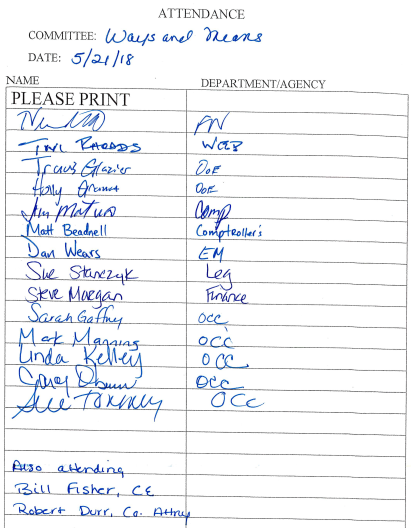
|
|




























































